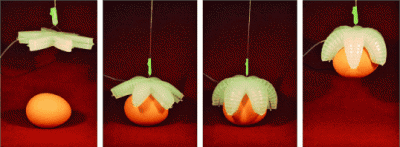Soft grip: Pneumatic elastomers as robotic arms

(PhysOrg.com) -- It looks like a starfish made of soft plastic. When air is blown into it through a thin tube it comes to life and the starfish closes like a hand. It does this so gently that it can grasp a raw egg without breaking it. This starfish-like grabber is the prototype for a pneumatic soft robotic arm made of soft plastic that has been introduced in the journal Angewandte Chemie by George M. Whitesides and his team at Harvard University (Boston, USA).
Whether used in the production of machines or modern surgery, in the deactivation of explosive devices or unmanned spacecraft, robots have become indispensable in many areas. However, the manipulation of delicate objects, such as fruit or internal organs, remains a difficult task for conventional hard robotic arms. It could be easier with soft robot components.
Whitesides and his co-workers want to realize this idea with a new approach based on pneumatic networks (PneuNets): they embedded channels in elastic plastics known as elastomers. To actuate movement, the channels are simply inflated like balloons. This causes the channels to expand into those areas of the elastomer that are the most yielding. In homogeneous elastomers, these are the areas with the thinnest walls; if there are different materials they are the areas with walls made of the softer, more elastic of the materials.
To make room for all of the bulky inflated channels next to each other, the entire component curves so that the more severely stretched walls are on the outside. To produce prototypes capable of complex movement, the researchers combined a series of such components.
How the component deforms depends on both the design and the materials used. Whitesides and his co-workers joined parts made of two different stiff silicon elastomers to program the movement. They were thus able to make starfish-like grabbers. Inflating these devices causes them to curl around an object to grasp it like fingers on a hand. Their touch is so soft that they can even be entrusted with a raw egg or a living mouse. In contrast to hard robotic arms, no complex precisely tuned control with sensors is necessary.
More information: George M. Whitesides, Soft Robotics for Chemists, Angewandte Chemie International Edition, dx.doi.org/10.1002/anie.201006464
Provided by Wiley



















